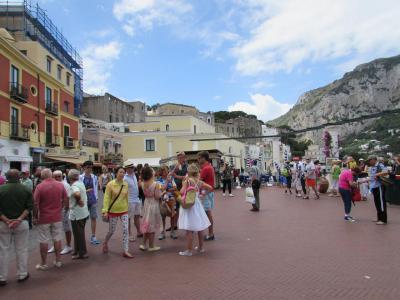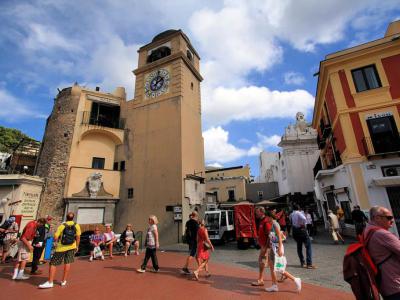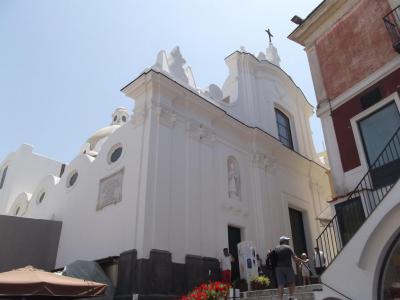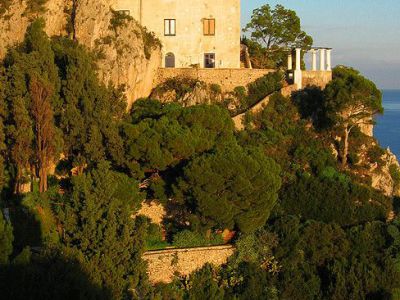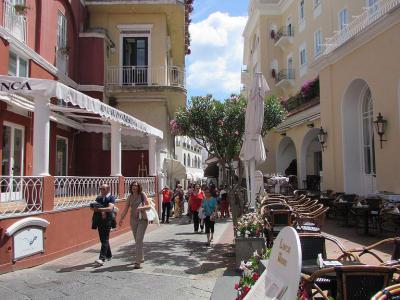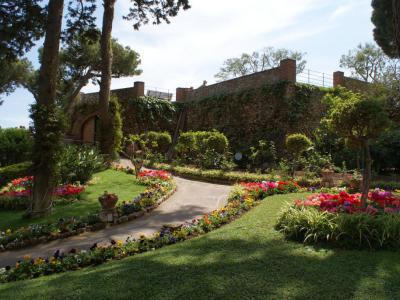
Capri Introduction Walking Tour (Self Guided), Capri
Located in the Tyrrhenian Sea, off the Sorrentine Peninsula on the southern side of Italy, the picturesque island of Capri is a celebrated beauty spot and coastal resort and one of the Mediterranean's must-see places.
The island's history spans from its early days in ancient times as a retreat for Roman emperors and nobles. The name "Capri" is believed to originate from the Ancient Greek word “Kápros” or the Latin "Capreae," which respectively refer to the wild boars or goats that are said to have roamed the island's rocky landscapes in the past.
Throughout the centuries, due to its strategic location, Capri has changed hands between different civilizations, especially the Greeks and Romans, who had their turn in shaping its cultural setting.
In the 19th century, Capri took on a new role as a haven for the European artistic elite and celebrities. People like Somerset Maugham, Russian author Maxim Gorky, Vladimir Lenin, and even Swedish Queen Victoria stayed on the island, adding another layer to its identity.
Exploring local attractions uncovers a wealth of experiences. Piazza Umberto I, affectionately known as the "Piazzetta," serves as the vibrant hub of Capri's social scene. Here, high-end boutiques and charming cafés create a lively stage.
Rising elegantly from the heart of the Piazzetta is the Torre dell'Orologio, a clock tower that graces the island's skyline.
Firmly seated within Capri's embrace is the Saint Stefan Church (Chiesa di Santo Stefano), a sanctuary of both spiritual devotion and architectural elegance.
Undoubtedly, no exploration of Capri is complete without indulging in Gelateria Buonocore's delectable ice-cream offerings, leaving behind the sweet aftertaste of culinary prowess.
Venturing further, you encounter the enigmatic Villa Solitaria, also known as the "Lonely Villa."
And of course, you cannot miss the terraced Gardens of Augustus, a living testament to the union of man's creativity and nature's untamed beauty.
In essence, Capri reads like a timeless verse, inviting us to engage with its history, luxuriate in its present, and anticipate its promising future. Its allure endures as a siren call to those seeking an encounter with the extraordinary. So, why not heed this call and embark on a journey to experience the enchantment of Capri firsthand?
The island's history spans from its early days in ancient times as a retreat for Roman emperors and nobles. The name "Capri" is believed to originate from the Ancient Greek word “Kápros” or the Latin "Capreae," which respectively refer to the wild boars or goats that are said to have roamed the island's rocky landscapes in the past.
Throughout the centuries, due to its strategic location, Capri has changed hands between different civilizations, especially the Greeks and Romans, who had their turn in shaping its cultural setting.
In the 19th century, Capri took on a new role as a haven for the European artistic elite and celebrities. People like Somerset Maugham, Russian author Maxim Gorky, Vladimir Lenin, and even Swedish Queen Victoria stayed on the island, adding another layer to its identity.
Exploring local attractions uncovers a wealth of experiences. Piazza Umberto I, affectionately known as the "Piazzetta," serves as the vibrant hub of Capri's social scene. Here, high-end boutiques and charming cafés create a lively stage.
Rising elegantly from the heart of the Piazzetta is the Torre dell'Orologio, a clock tower that graces the island's skyline.
Firmly seated within Capri's embrace is the Saint Stefan Church (Chiesa di Santo Stefano), a sanctuary of both spiritual devotion and architectural elegance.
Undoubtedly, no exploration of Capri is complete without indulging in Gelateria Buonocore's delectable ice-cream offerings, leaving behind the sweet aftertaste of culinary prowess.
Venturing further, you encounter the enigmatic Villa Solitaria, also known as the "Lonely Villa."
And of course, you cannot miss the terraced Gardens of Augustus, a living testament to the union of man's creativity and nature's untamed beauty.
In essence, Capri reads like a timeless verse, inviting us to engage with its history, luxuriate in its present, and anticipate its promising future. Its allure endures as a siren call to those seeking an encounter with the extraordinary. So, why not heed this call and embark on a journey to experience the enchantment of Capri firsthand?
How it works: Download the app "GPSmyCity: Walks in 1K+ Cities" from Apple App Store or Google Play Store to your mobile phone or tablet. The app turns your mobile device into a personal tour guide and its built-in GPS navigation functions guide you from one tour stop to next. The app works offline, so no data plan is needed when traveling abroad.
Capri Introduction Walking Tour Map
Guide Name: Capri Introduction Walking Tour
Guide Location: Italy » Capri (See other walking tours in Capri)
Guide Type: Self-guided Walking Tour (Sightseeing)
# of Attractions: 8
Tour Duration: 1 Hour(s)
Travel Distance: 1.9 Km or 1.2 Miles
Author: nataly
Sight(s) Featured in This Guide:
Guide Location: Italy » Capri (See other walking tours in Capri)
Guide Type: Self-guided Walking Tour (Sightseeing)
# of Attractions: 8
Tour Duration: 1 Hour(s)
Travel Distance: 1.9 Km or 1.2 Miles
Author: nataly
Sight(s) Featured in This Guide:
- Piazza Umberto I (Umberto I Square)
- Torre dell'Orologio (Clock Tower)
- Chiesa di Santo Stefano (Saint Stefan Church)
- Gelateria Buonocore
- Villa Solitaria (Lonely Villa)
- Via Camerelle (Camerelle Street)
- The Charterhouse of St. Giacomo
- The Gardens of Augustus
1) Piazza Umberto I (Umberto I Square) (must see)
Umberto I Square, commonly known as Piazzetta, holds a special place within the enchanting island of Capri With a history stretching back to Roman times, this square has consistently been regarded as the heart of the town and a pivotal meeting point for both locals and visitors. Fondly referred to as "the little theater of the world," Piazzetta's significance and charm are undeniable.
At the heart of the square stands the clock tower, an iconic feature that has become inseparable from the image of Capri. Its origins are shrouded in mystery, with theories suggesting that it might have been inspired by elements from the church of Hagia Sophia or an ancient watchtower from the adjacent wall.
The square's history and character have been molded by various historical events and transformations. The church of Santo Stefano, built in the eighteenth century, was converted into a cathedral when the Bishop of Capri established his residence there. This church, linked to the square by a staircase, was an integral part of the square's development. However, in 1818, under the decree of Pope Pius VII, the diocese was abolished, and Capri was absorbed into the Diocese of Sorrento.
Umberto I Square's transformation into a vibrant hub of social life came to be in the 20th century. In the early 1900s, it was known for hosting bustling produce markets. Yet, it gained a more cosmopolitan flair when Raffaele Vuotto introduced his Grand Café Vuotto between 1934 and 1938. The café's outdoor seating arrangement revolutionized the square, inspiring other locals to open their businesses. Subsequently, Umberto I Square evolved into the bustling and inviting social center that it is known as today.
At the heart of the square stands the clock tower, an iconic feature that has become inseparable from the image of Capri. Its origins are shrouded in mystery, with theories suggesting that it might have been inspired by elements from the church of Hagia Sophia or an ancient watchtower from the adjacent wall.
The square's history and character have been molded by various historical events and transformations. The church of Santo Stefano, built in the eighteenth century, was converted into a cathedral when the Bishop of Capri established his residence there. This church, linked to the square by a staircase, was an integral part of the square's development. However, in 1818, under the decree of Pope Pius VII, the diocese was abolished, and Capri was absorbed into the Diocese of Sorrento.
Umberto I Square's transformation into a vibrant hub of social life came to be in the 20th century. In the early 1900s, it was known for hosting bustling produce markets. Yet, it gained a more cosmopolitan flair when Raffaele Vuotto introduced his Grand Café Vuotto between 1934 and 1938. The café's outdoor seating arrangement revolutionized the square, inspiring other locals to open their businesses. Subsequently, Umberto I Square evolved into the bustling and inviting social center that it is known as today.
2) Torre dell'Orologio (Clock Tower)
Standing proudly in one of the corners of the renowned square of Capri is the Clock Tower, an architectural masterpiece that exudes both beauty and grandeur. Known also as the Piazzetta Tower, this structure is a captivating testament to the history and culture of the region.
With its origins tracing back to the X - XI century, the Clock Tower holds echoes of an ancient Byzantine convent, possibly dedicated to Santo Stefano. This historical connection lends an air of mystique to the tower, as one can imagine the centuries of stories it has silently witnessed. Its initial purpose might have been religious, a beacon of timekeeping for the devoted within the serene walls of the convent.
However, the present-day incarnation of the tower took shape in the 18th century. This transformation was likely a result of the restoration efforts that coincided with the reconstruction or renovation of the former cathedral of Santo Stefano. The tower's design and architecture from this period have left an indelible mark on Capri's skyline, and it has become an iconic symbol of the island's heritage.
The Clock Tower's form is both elegant and commanding. Rising from a square base, it draws the gaze upward towards its crowning features. The most distinctive of these is the oriental dome that graces its peak. This dome, with its architectural influences from the East, adds an element of uniqueness to the tower's design, setting it apart from conventional clock towers.
With its origins tracing back to the X - XI century, the Clock Tower holds echoes of an ancient Byzantine convent, possibly dedicated to Santo Stefano. This historical connection lends an air of mystique to the tower, as one can imagine the centuries of stories it has silently witnessed. Its initial purpose might have been religious, a beacon of timekeeping for the devoted within the serene walls of the convent.
However, the present-day incarnation of the tower took shape in the 18th century. This transformation was likely a result of the restoration efforts that coincided with the reconstruction or renovation of the former cathedral of Santo Stefano. The tower's design and architecture from this period have left an indelible mark on Capri's skyline, and it has become an iconic symbol of the island's heritage.
The Clock Tower's form is both elegant and commanding. Rising from a square base, it draws the gaze upward towards its crowning features. The most distinctive of these is the oriental dome that graces its peak. This dome, with its architectural influences from the East, adds an element of uniqueness to the tower's design, setting it apart from conventional clock towers.
3) Chiesa di Santo Stefano (Saint Stefan Church)
The monumental Saint Stefan Church holds a prominent place both in terms of its historical significance and its architectural grandeur. This majestic church, also known as Saint Stefan Church, is renowned as the largest on the island, serving as the parish seat and once serving as the cathedral of the Diocese of Capri from 1560 to 1818.
The origins of Saint Stefan Church are intertwined with an earlier religious site dedicated to Santa Sofia and an ancient Benedictine monastery dating back to 580. While only the bell tower on the Piazzetta remains from this older establishment, the current church was erected in 1688 based on a design by the architect Francesco Antonio Picchiatti.
It was ultimately completed in 1697 with the contribution of Marziale Desiderio's construction efforts. The consecration ceremony took place on May 17, 1723, officiated by Bishop Michele Vandeneyndel, marking the church's elevation to the status of the Cathedral of Capri. However, the finishing touches continued until 1751, focusing on the choir and various interior arrangements. Unfortunately, with the dissolution of the Diocese of Capri in 1818, the church lost its bishopric status.
The facade of Saint Stefan Church is an impressive sight, split into two sections by an entablature. The lower part features a central main portal, adorned with faux marble panels, flanked by niches containing statues of saints, and accentuated by pilasters. Above, the smaller upper portion boasts a central large window and terminates with elegant volutes. The entirety of the facade is adorned with intricate stucco decorations.
The origins of Saint Stefan Church are intertwined with an earlier religious site dedicated to Santa Sofia and an ancient Benedictine monastery dating back to 580. While only the bell tower on the Piazzetta remains from this older establishment, the current church was erected in 1688 based on a design by the architect Francesco Antonio Picchiatti.
It was ultimately completed in 1697 with the contribution of Marziale Desiderio's construction efforts. The consecration ceremony took place on May 17, 1723, officiated by Bishop Michele Vandeneyndel, marking the church's elevation to the status of the Cathedral of Capri. However, the finishing touches continued until 1751, focusing on the choir and various interior arrangements. Unfortunately, with the dissolution of the Diocese of Capri in 1818, the church lost its bishopric status.
The facade of Saint Stefan Church is an impressive sight, split into two sections by an entablature. The lower part features a central main portal, adorned with faux marble panels, flanked by niches containing statues of saints, and accentuated by pilasters. Above, the smaller upper portion boasts a central large window and terminates with elegant volutes. The entirety of the facade is adorned with intricate stucco decorations.
4) Gelateria Buonocore
Gelateria Buonocore traces its roots back to 1950, when Raffaele Buonocore first embarked on a journey of gastronomic exploration. This establishment has become an integral part of Capri's rich culinary history.
The Buonocore story begins on the charming streets of Capri, where Raffaele opened a delicatessen on via Roma. It was here that the foundation for the Buonocore legacy was laid, rooted in a dedication to quality and an unwavering commitment to offering delectable delights. In 1952, fate intertwined Raffaele's life with Carmela's, and together, they transformed their enterprise into a pioneering fry shop – Capri's first foray into the world of street food.
As time flowed on, the Buonocore family's culinary prowess continued to evolve. In 1973, the Buonocore establishment found its new home at via Vittorio Emanuele 35. It was here that the Buonocore family seamlessly integrated the realms of pastry and ice cream into their business, forging a connection between Capri's sweetest indulgences and the island's cherished traditions.
The reins of Buonocore's legacy were passed onto the next generation, with Ferdinando, Ersilia, Giovanna, and Mario – Raffaele and Carmela's children – taking up the mantle. Their collective vision and dedication transformed Gelateria Buonocore into more than just a shop; it became a cherished institution, a custodian of Capri's gastronomic heritage.
The Buonocore story begins on the charming streets of Capri, where Raffaele opened a delicatessen on via Roma. It was here that the foundation for the Buonocore legacy was laid, rooted in a dedication to quality and an unwavering commitment to offering delectable delights. In 1952, fate intertwined Raffaele's life with Carmela's, and together, they transformed their enterprise into a pioneering fry shop – Capri's first foray into the world of street food.
As time flowed on, the Buonocore family's culinary prowess continued to evolve. In 1973, the Buonocore establishment found its new home at via Vittorio Emanuele 35. It was here that the Buonocore family seamlessly integrated the realms of pastry and ice cream into their business, forging a connection between Capri's sweetest indulgences and the island's cherished traditions.
The reins of Buonocore's legacy were passed onto the next generation, with Ferdinando, Ersilia, Giovanna, and Mario – Raffaele and Carmela's children – taking up the mantle. Their collective vision and dedication transformed Gelateria Buonocore into more than just a shop; it became a cherished institution, a custodian of Capri's gastronomic heritage.
5) Villa Solitaria (Lonely Villa)
The Lonely Villa stands as a testament to time and inspiration. Constructed between 1907 and 1910 by Edwin Cerio (1875–1960), an illustrious Italian writer, engineer, architect, historian, and botanist, this national historic house bears the mark of a visionary mind.
It is a secluded haven surrounded by cliffs and Mediterranean flora. While its isolation offers a tranquil retreat, the vibrant heart of Capri's central piazzetta is only minutes away. From this vantage point, the villa offers a mesmerizing view of the iconic Faraglioni, the famed rocky stacks that have captivated the imagination for centuries.
The villa's origins are steeped in history, with its foundations and the walls of its theater-shaped garden dating back to the middle ages or perhaps even earlier. Edwin Cerio approached the villa's construction with an unconventional approach, forgoing predetermined plans. Instead, he collaborated with local masons, imbuing each window with what he referred to as "a painting signed by God." The interior is adorned with ceramic floors featuring lilies and thistles, while excerpts from the poetic Song of Songs grace the walls, evoking a sense of timeless beauty.
Villa Solitaria found itself at the forefront of architectural innovation, drawing praise from Filippo Tommaso Marinetti, the founder of the Futurism movement. Marinetti lauded the villa as a pioneering example of futurist architecture in Italy, celebrated for its verticality and visionary spatial concepts.
Between 1914 and 1924, Edwin Cerio leased the villa to Sir Edward Compton MacKenzie, a renowned Scottish writer. During this tenure, La Solitaria became a vibrant hub for English writers in Capri, hosting luminaries like Norman Douglas, Francis Brett Young, William Butler Yeats, and David Herbert Lawrence. The villa's charm also attracted the likes of Scottish music critic and composer Cecil Gray. Compton MacKenzie's shared passion for botany led to the planting of pines, cypress, and exotic plants gathered from their worldwide travels, infusing the villa's ambiance with a touch of the exotic.
It is a secluded haven surrounded by cliffs and Mediterranean flora. While its isolation offers a tranquil retreat, the vibrant heart of Capri's central piazzetta is only minutes away. From this vantage point, the villa offers a mesmerizing view of the iconic Faraglioni, the famed rocky stacks that have captivated the imagination for centuries.
The villa's origins are steeped in history, with its foundations and the walls of its theater-shaped garden dating back to the middle ages or perhaps even earlier. Edwin Cerio approached the villa's construction with an unconventional approach, forgoing predetermined plans. Instead, he collaborated with local masons, imbuing each window with what he referred to as "a painting signed by God." The interior is adorned with ceramic floors featuring lilies and thistles, while excerpts from the poetic Song of Songs grace the walls, evoking a sense of timeless beauty.
Villa Solitaria found itself at the forefront of architectural innovation, drawing praise from Filippo Tommaso Marinetti, the founder of the Futurism movement. Marinetti lauded the villa as a pioneering example of futurist architecture in Italy, celebrated for its verticality and visionary spatial concepts.
Between 1914 and 1924, Edwin Cerio leased the villa to Sir Edward Compton MacKenzie, a renowned Scottish writer. During this tenure, La Solitaria became a vibrant hub for English writers in Capri, hosting luminaries like Norman Douglas, Francis Brett Young, William Butler Yeats, and David Herbert Lawrence. The villa's charm also attracted the likes of Scottish music critic and composer Cecil Gray. Compton MacKenzie's shared passion for botany led to the planting of pines, cypress, and exotic plants gathered from their worldwide travels, infusing the villa's ambiance with a touch of the exotic.
6) Via Camerelle (Camerelle Street) (must see)
Camerelle Street stands as a testament to the rich history, elegance, and allure that define this iconic destination. With its captivating blend of antiquity and modern luxury, this famous street is a must-visit for those seeking a glimpse into the soul of Capri's unique atmosphere.
Once known as Via Anticaglia, Camerelle Street has a history that dates back to ancient times, woven with the threads of Roman grandeur. The street draws its name from the ancient Roman cisterns discovered along its path. These cisterns, originally constructed as foundations for the road connecting Castiglione to the imperial villa of Tragara, serve as tangible remnants of Capri's past. Walking along Camerelle Street is akin to strolling through a living museum, with each step leading you through centuries of history.
In the modern era, Camerelle Street has evolved into the beating heart of Capri's luxury shopping scene. The street boasts a lineup of exclusive boutiques that house some of Italy's and the world's most prestigious fashion brands. These storefronts, adorned with elegant displays, beckon to fashion enthusiasts and discerning shoppers from around the globe. From exquisite clothing to opulent accessories, dazzling jewelry to alluring perfumes, the boutiques of Camerelle Street cater to those with a taste for the finer things in life.
Beyond its historical significance and luxury offerings, Camerelle Street casts a spell with its enchanting ambiance. The architecture along the street speaks of traditional Capri style, with vibrant colored facades and delicate flower-laden balconies. The fragrant air is an intoxicating blend of the scents from luxurious boutiques and the blossoms of Mediterranean flora. As you wander, hidden courtyards and picturesque alleyways invite exploration, adding an air of mystique and romance to the journey.
Once known as Via Anticaglia, Camerelle Street has a history that dates back to ancient times, woven with the threads of Roman grandeur. The street draws its name from the ancient Roman cisterns discovered along its path. These cisterns, originally constructed as foundations for the road connecting Castiglione to the imperial villa of Tragara, serve as tangible remnants of Capri's past. Walking along Camerelle Street is akin to strolling through a living museum, with each step leading you through centuries of history.
In the modern era, Camerelle Street has evolved into the beating heart of Capri's luxury shopping scene. The street boasts a lineup of exclusive boutiques that house some of Italy's and the world's most prestigious fashion brands. These storefronts, adorned with elegant displays, beckon to fashion enthusiasts and discerning shoppers from around the globe. From exquisite clothing to opulent accessories, dazzling jewelry to alluring perfumes, the boutiques of Camerelle Street cater to those with a taste for the finer things in life.
Beyond its historical significance and luxury offerings, Camerelle Street casts a spell with its enchanting ambiance. The architecture along the street speaks of traditional Capri style, with vibrant colored facades and delicate flower-laden balconies. The fragrant air is an intoxicating blend of the scents from luxurious boutiques and the blossoms of Mediterranean flora. As you wander, hidden courtyards and picturesque alleyways invite exploration, adding an air of mystique and romance to the journey.
7) The Charterhouse of St. Giacomo
Steeped in centuries of significance, the Charterhouse of St. Giacomo holds within its walls a tapestry of stories that reflect the island's rich past. The entrance to the Charterhouse is a path that winds through time, culminating next to a formidable fortified tower that guards its hallowed halls. The Charterhouse unfolds before visitors in three distinct blocks, each bearing witness to different facets of life within its walls.
The first block, detached from the main convent, is home to the pharmacy and the women's church. Here, history and devotion intersect as the echoes of healing herbs and sacred prayers linger in the air. The second block, a hub of activity, accommodates the converse monks and external guests. Annexed to this section are granaries, stables, and workshops, where the steady hum of craftsmanship and daily life once thrived. The third block, perhaps the most intimate and contemplative, was dedicated to seclusion and introspection. In this realm of quietude, cells encircle the grandeur of Choistro Grande cloister, while other chambers envelop the serenity of Chiostro Piccolo.
The architecture of the Charterhouse is a blend of renaissance finesse and timeless spirituality. The Chiostro Grande beckons with its late renaissance design, characterized by cross vaults supported by sturdy stone columns. At its heart, a geometric arrangement embraces green spaces, creating an oasis of tranquility and reflection.
Chiostro Piccolo, in contrast, exudes delicate elegance. Its cross vaults gracefully rest upon Roman marble columns, each bearing the weight of history and the passage of time.
The Charterhouse halls, once abuzz with the prayers of monks and the rhythms of life, now host a High School that bridges education and heritage. The Diefenbach Museum finds its home within these hallowed walls, offering visitors a glimpse into the artistic tapestry of the island's history. During the summer months, the Charterhouse transforms once more into a stage for cultural events, resonating with the melodies of concerts and the energy of gatherings.
The first block, detached from the main convent, is home to the pharmacy and the women's church. Here, history and devotion intersect as the echoes of healing herbs and sacred prayers linger in the air. The second block, a hub of activity, accommodates the converse monks and external guests. Annexed to this section are granaries, stables, and workshops, where the steady hum of craftsmanship and daily life once thrived. The third block, perhaps the most intimate and contemplative, was dedicated to seclusion and introspection. In this realm of quietude, cells encircle the grandeur of Choistro Grande cloister, while other chambers envelop the serenity of Chiostro Piccolo.
The architecture of the Charterhouse is a blend of renaissance finesse and timeless spirituality. The Chiostro Grande beckons with its late renaissance design, characterized by cross vaults supported by sturdy stone columns. At its heart, a geometric arrangement embraces green spaces, creating an oasis of tranquility and reflection.
Chiostro Piccolo, in contrast, exudes delicate elegance. Its cross vaults gracefully rest upon Roman marble columns, each bearing the weight of history and the passage of time.
The Charterhouse halls, once abuzz with the prayers of monks and the rhythms of life, now host a High School that bridges education and heritage. The Diefenbach Museum finds its home within these hallowed walls, offering visitors a glimpse into the artistic tapestry of the island's history. During the summer months, the Charterhouse transforms once more into a stage for cultural events, resonating with the melodies of concerts and the energy of gatherings.
8) The Gardens of Augustus (must see)
Perched on the enchanting island of Capri, the Gardens of Augustus, originally known as Krupp Gardens, bloom as a living tribute to nature's beauty. These botanical gardens, with their captivating history and panoramic vistas, embody the essence of the island's allure.
The story of the Gardens of Augustus begins with Friedrich Alfred Krupp, a German industrialist with a vision. In the early twentieth century, Krupp established these gardens as part of his grand plan to build a mansion on the island. Initially named "Krupp Gardens," they bore witness to the aspirations of a man drawn to the island's natural splendor.
A shift occurred in 1918 when the gardens underwent a transformation, acquiring a new name that would echo through the ages: the Gardens of Augustus. Designed with meticulous care, the gardens unfold in terraces that cascade toward the sea. Here, the rich flora of Capri finds expression in ornamental plants and flowers, a vibrant tapestry that includes the likes of geraniums, dahlias, and brooms.
A unique feature within these gardens is the monument to Vladimir Lenin, a rarity in Italy. This tribute, crafted in 1968 by the skilled hands of Italian sculptor Giacomo Manzu, stands as a testament to history's interconnected threads. The monument, composed of imposing blocks of marble, is a profound symbol of international relations, honoring the legacy of Lenin.
From the Gardens of Augustus, a panoramic canvas unfolds, offering a 180-degree view that captures the essence of Capri's beauty. Mount Solaro stands as a guardian in the distance, while the bay of Marina Piccola stretches before the eyes like a tranquil painting. The iconic Faraglioni, those ancient rocky stacks that have captivated artists and poets alike, find their place in this vista, etching their silhouette against the canvas of the sky and sea.
The story of the Gardens of Augustus begins with Friedrich Alfred Krupp, a German industrialist with a vision. In the early twentieth century, Krupp established these gardens as part of his grand plan to build a mansion on the island. Initially named "Krupp Gardens," they bore witness to the aspirations of a man drawn to the island's natural splendor.
A shift occurred in 1918 when the gardens underwent a transformation, acquiring a new name that would echo through the ages: the Gardens of Augustus. Designed with meticulous care, the gardens unfold in terraces that cascade toward the sea. Here, the rich flora of Capri finds expression in ornamental plants and flowers, a vibrant tapestry that includes the likes of geraniums, dahlias, and brooms.
A unique feature within these gardens is the monument to Vladimir Lenin, a rarity in Italy. This tribute, crafted in 1968 by the skilled hands of Italian sculptor Giacomo Manzu, stands as a testament to history's interconnected threads. The monument, composed of imposing blocks of marble, is a profound symbol of international relations, honoring the legacy of Lenin.
From the Gardens of Augustus, a panoramic canvas unfolds, offering a 180-degree view that captures the essence of Capri's beauty. Mount Solaro stands as a guardian in the distance, while the bay of Marina Piccola stretches before the eyes like a tranquil painting. The iconic Faraglioni, those ancient rocky stacks that have captivated artists and poets alike, find their place in this vista, etching their silhouette against the canvas of the sky and sea.
The Most Popular Cities
/ view all
